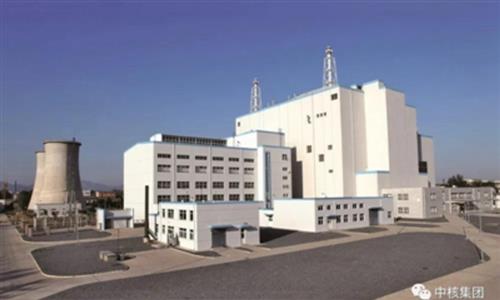IN-DEPTH / IN-DEPTH
Innovations in Chinese uranium mining technology promote development of eco-friendly and digitalized mines

A view of the grassland above the digital in-situ leach uranium mine operated by Tongliao Uranium Industry Qianjiadian Mine Photo: Courtesy of CNNC
On the grasslands of Tongliao, North China's Inner Mongolia Autonomous Region, herds of cattle and sheep leisurely graze as the wind gently blows through the vast expanse. This picturesque scene of nature paints a green impression left by a uranium extraction digital well in China.In this verdant landscape, where hardly any traces of excavation can be seen, small boxes are placed every few meters. Inside these boxes, thin liquid extraction tubes, only as thick as an adult's wrist, are inserted into the ground, providing essential energy for the development of China's nuclear industry.
This digital in-situ leach uranium mine, operated by Tongliao Uranium Industry Qianjiadian Mine, China National Nuclear Corporation (CNNC) Inner Mongolia Mining Co, Ltd, is the first eco-friendly in-situ leach uranium mine independently developed and constructed in China. It pioneers the industrialized use of carbon dioxide and oxygen for uranium extraction, accumulating rich management and operational experience for the construction of green uranium mines in the country.
Meanwhile, the CNNC Inner Mongolia Mining Co, Ltd is a pioneer in the large-scale, intensive, and intelligent development of uranium resources in China. It houses China's first big data intelligent analysis center for in-situ leach uranium mines and a digital in-situ leach remote control center, enabling "remote uranium extraction, one-click control, all on one screen."
Industry insiders said that China is currently exploring a new approach to uranium mining that is safe, green, cost-effective, highly automated, and informatized.
Eco-friendly mining
Uranium is the main fuel for nuclear reactors, and a vital strategic resource for the nuclear industry.
Although China has relatively abundant uranium resources, they are characterized by low grade, small scale and complex conditions. Over the years, China's nuclear industry has driven significant advancements in uranium mining and metallurgy technology through ongoing technological research, promoting the transformation and upgrading of the natural uranium industry.
This year marks the 60th anniversary of China's first atomic bomb detonation. In 1958, despite a weak domestic industrial base and a foreign technological blockade, China's mining research team still produced tons of uranium dioxide and uranium tetrafluoride in the shortest possible time, refined the country's first uranium and thorium ingots, and accelerated the testing process of the first atomic bomb, making China's first atomic bomb test 365 days ahead of schedule.
Digging ore from depths of hundreds of meters, transporting it to the surface, and then processing it to extract uranium through various physical and chemical means remains the mainstream method of uranium mining worldwide. In the past, such conventional methods have supported the development of China's nuclear industry. However, this traditional approach involves high mining costs, lower safety, and generates waste gas, wastewater and waste residue.
For a long time, China's uranium mining innovation team has been thinking: Can we drill holes on the surface, add an aqueous solution containing chemical reagents, dissolve the uranium in the ore, and then extract it from another hole without conventional mining? This led the CNNC scientific research team to pioneer and establish the scientific preparation of carbon dioxide and oxygen leaching agents and the extraction method of uranium using a carbonic acid system.
"Compared with conventional hard rock mining, ground leaching uranium eliminates the ore mining process, and the raw material consumption, labor cost and working environment are optimized," Yang Yihan, head of the CNNC Inner Mongolia Mining Co, Ltd, told the Global Times.
Empowered by technology
Stepping into the water metallurgy plant of Tongliao Uranium industry, the Global Times reporter found the spacious and bright factory building, devoid of dust and the deafening roar of machinery. Not a worker in sight; only the numbers displayed on the pressure gauges and flow meters of the adsorption towers indicated that production was underway.
Tang Qingsi, deputy general manager of CNNC Tongliao Uranium Industry Co, Ltd, told the Global Times that the entire uranium mine has currently achieved automation of in-situ production processes, reduced the need for manpower in mining operations, and digitized key process flows.
All production process data is transmitted in real time to the remote control center of the Inner Mongolia Mining Digital Immersion Center of CNNC, enabling "remote control from a thousand miles away, one-click uranium mining, and control at a glance," said Tang.
"The digital transformation not only improves the production quality and efficiency of uranium mining and smelting processes, but also reduces the production cost. Through intelligent production, workers in uranium mining are able to return to the city from the Gobi, grasslands and deserts," said Zhang Yong, deputy general manager of CNNC Inner Mongolia Mining Co, Ltd, emphasizing that this revolutionary change has broken the traditional production model where a worker's production and life are completely tied to the mine.
Yang said that with the development of intelligent and digital technology, the production capacity and per capita productivity of uranium leaching in China have increased by more than 10 times.
Compared with foreign countries, China's distinctive uranium resource endowment has spurred its uranium mining industry to develop and master the most comprehensive range of resource development technologies globally, which enable the country to confront even the most complex situations, said Min Ping, chairman of China Nuclear Mining Science and Technology Corporation (CNMSTC).
"I am proud to say that all the uranium mines in operation and even decommissioned in China are using self-developed technology, and our 'Chinese solution' for uranium mining has gone global, leading the world," she stressed.
With the increasing demand and development challenges associated with natural uranium resources, exploring and exploiting unconventional uranium resources has become an important strategic choice for many countries in addition to developing terrestrial uranium resources.
One such example is extracting uranium from seawater. Although the concentration of uranium in seawater is low, the potential resource is vast, estimated at 4.5 billion tons of uranium, Min said, noting that at present, CNMSTC is conducting cutting-edge research and development, hoping to break through key technical bottlenecks hindering the industrialization of uranium extraction from seawater by 2050. The goal is to achieve continuous production of uranium extraction from seawater, she said.

